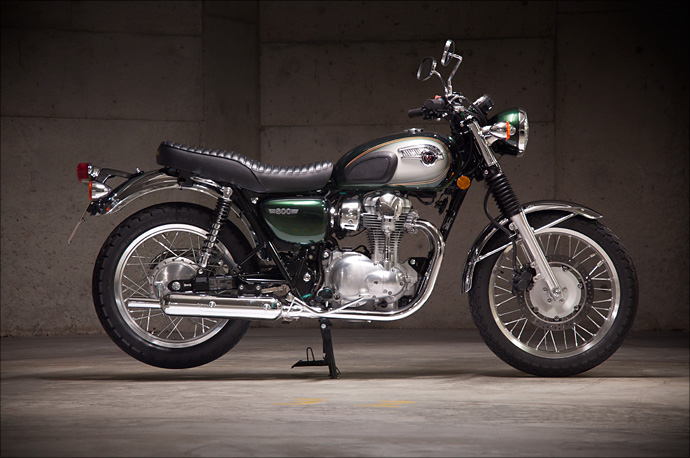 Stand down and be counted – meet the new W
Stand down and be counted – meet the new W
My Dad. Knows absolutely nothing about motorbikes bar their mechanical basics and (in his eyes at least) their inherent danger – that and whatever his still-sharp 60 year-old senses tell him. So picture the vista when I roll up to my parent’s farm for Mother’s Day on a brand new Kawasaki W800. Of course he knows that the last bike I reviewed was Zero’s brave but flawed Zero S, and he briefly casts his eyes over this new one as I rev it up to give him a listen to the engine. There’s a moment of deep contemplation, much like a Kung Fu master might do, then he calmly pronounces, “Another electric bike, is it?” I laugh out loud. An electric bike? “Come on! Just look at the thing,” I blurt, pointing out the two massive pipes hanging off the back. “I know it doesn’t look like an electric bike,” he replies. “But it sure does sound like one…”
Please do meet Kawasaki’s all new W800 – a rethink of the popular W650 and their tilt at the ever-expanding “classic” bike segment. As we all know, the W650 was quite a hit with the custom crowd and has produced many superb DIY rides including a few corkers from local Sydney hipsters Deus Ex Machina. The intro blurb on the company website points out the attention to detail and “authentic quality” gained from using a plethora of metal and chrome on the bike – no doubt in an attempt to lure both older riders with a longing for the good ol’ days and younger riders who are possibly looking to get in on the custom bike craze. Kawasaki are also very quick to mention that the bike’s a homage to their original W1 parallel twin of 1967 – but do note that a homage is all that it is, as the W1 has almost nothing in common with the W650 or W800 excepting the parallel twin engine configuration and a 360˙ firing order.
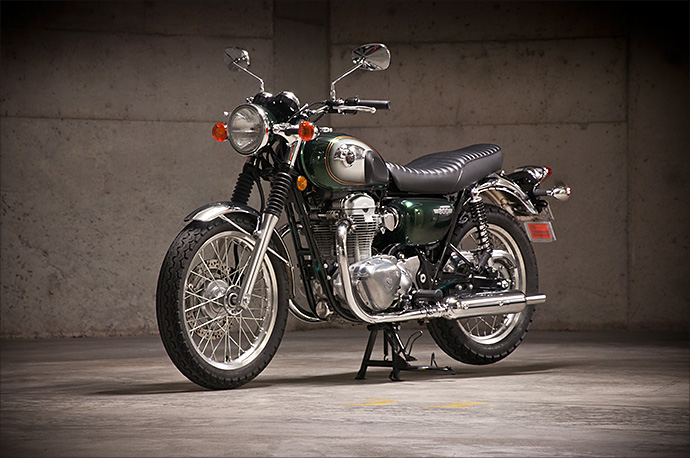 A tip for budding photographers – when shooting a bike with two stands, ensure they are not both down at the same time
A tip for budding photographers – when shooting a bike with two stands, ensure they are not both down at the same time
Naturally, the engine’s an air-cooled number with a capacity of 773cc. By Kawasaki’s measure, the power produced is around 52Kw (70 hp), up from 37 Kw (50 hp) of the previous model; torque is spun out of the new block at 60Nm (76 ft. lbs.) as compared to the 41Nm (56 ft. lbs.) of the 676cc W650. All this is happening much lower in the rev range than the old bike, with maximum torque available at 2500 rpm – 2000 rpm lower than the six fiddy. You’ve got a five-speed box to toe through, and a 14 ltr (4 gal) tank to pour the petroleum downwards. The frame is good ol’ tube steel and it all weighs in at 216 kg (476 lbs.), with the seat stopping your bum’s downwards motion at 790mm (31”). The rest is completely as you’d expect with telescopic front forks (no adjustment), twin rear shockers (pre-load adjustment), disc front and drum rear. It’ll cost you 12 thousand biscuits if you pay recommended retail in Oz.
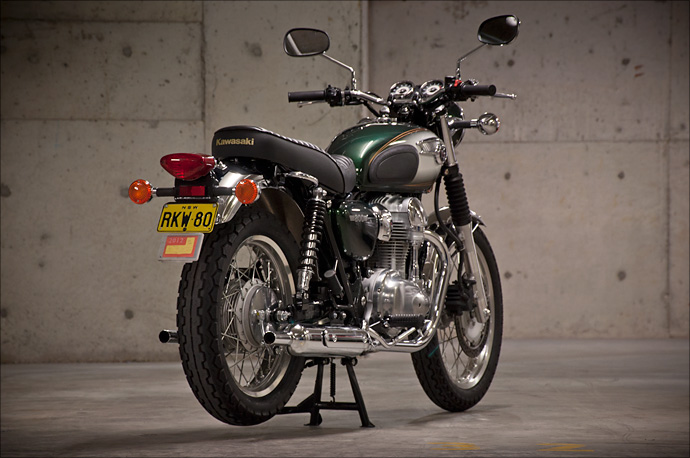
The bike is impressive on first sighting. All that chrome burns shininess into your retinas and you can’t help but be impressed. When you have recovered your sight, the finer details also please. There’s nothing that jumped out to my fussy eyes as under-done or budget-looking and the chrome is obviously nice and thick – and at that weight it’d want to be. What about the colours? We do hope sir likes dark green, because that’s the sum total of the choices available, though there’s so little surface area on the bike that isn’t chromed I’m not sure that it’d make a whole lot of difference. You can bet your bottom dollar there will be more colours announced soon, too. Jumping on board confirms that it’s not a featherweight. It’s not Harley heavy either, but just substantial enough for you to think twice when doing your first few U-turns.
Somewhat quizzically, it’s been placed in the “Sports” section of the company’s line-up alongside the likes of the Z1000 naked and 1400GTR Hayabusa buster, but once you sight that heart-shaped tank from the rider’s position you can’t help but think there’s more than a little cruiser in the bike’s genes. Of course the weight only adds to that impression. The retro feel of the bike is handled with grace and thankfully not overdone anywhere. I find that a bike’s dials are a decent gauge (pun fully intended) of excessively retro intentions on many bikes in this class and often end up looking more like a prop from an Austin Powers film than something that you’d be happy to look at on a regular basis. These ones pass the test nicely, with only the slightest hint of old school in the font chosen for the numerals. And yes, the bike does pass the Sunday morning smile-on-first-sighting test. It’s a looker, no doubt about it.
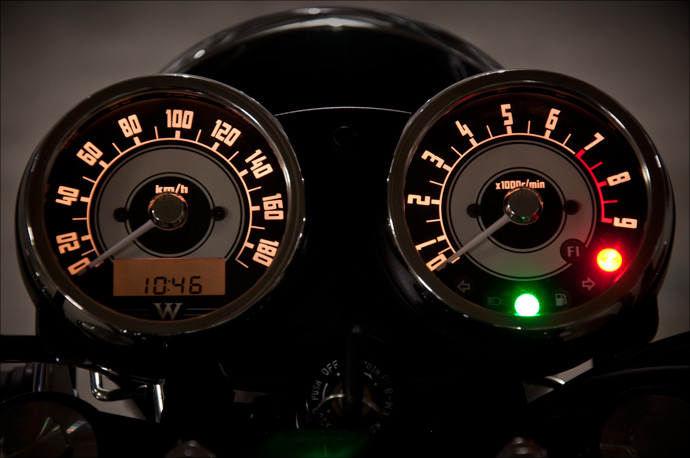 Retro, without being lame-o. Electronic display cycles through odo, trip, and time
Retro, without being lame-o. Electronic display cycles through odo, trip, and time
One thing that did strike me as odd, though, was the lack of any Kawasaki branding on the bike save for the company moniker on the rear of the nicely padded seat. The tank itself has a simply “W” badge that looks more than a little like the classic Triumph eyebrow. This made me stop and think as to why they would do that; sure they probably want to impress on people the heritage of the brand and all that but I for one couldn’t really think of another example of this kind of badging on a bike. Weird. Picturing myself as an owner, I’d be worried that I would end up being constantly asked, “What kind of bike is a W?” over and over. Say it loud and say it proud, guys. It’s a Kawasaki! There’s nothing to be ashamed of there.
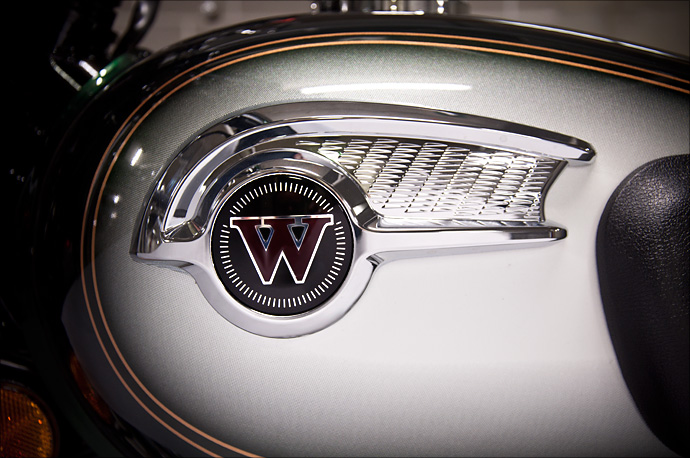 No relation to George, we assume
No relation to George, we assume
The engine turns over at the mere whiff of starter (no kick-start option I’m afraid) and settles in a neat and orderly humming belying its modern design, electronic choke and fancy-pants fuel injection. A twist of the throttle or two allows the bevel-drive cam to throw its hand up in the noise classroom and be noticed. Then it strikes me. The metallic whine of bevel gears is all I can hear. Where’s the beautiful retro parallel twin exhaust pop-a-pops in this musical mix? Nowhere – that’s where. I then think that the bike might fiddle with some valves once I get on the road, but alas and alack it never eventuates. Even at highway speeds with a heap of revs showing all I ever hear is the power-station hum of the bevel and an almost indiscernible bass line that just rumbles away in the background without ever developing into something that would rouse the hairs on your neck (or in my case, my back) to any degree. More’s the pity as the pipes are a thing of beauty; all that glorious chrome for such little result. I can only assume that the engineers were paying too much attention to the noisy bike police and not enough to the riders who shell out the dollars on the showroom floor. Of course this was the very conundrum my Dad was commenting on, albeit in his own, “get right to the crux of the matter without really knowing that he’s doing so” kind of way.
Out on the bitumen bits the W starts to reveal it’s true character. The thing is totally buttoned down and as slick as a damn big bucket of freshly polished slick stuff. All very modern, seamless and totally unlike the retro image it fronts. Gear changes are silky, suspension is smooth and it’s rarely troubled by your general assortment of Sydney road acne. As with any mortal parallel twin it’s vibey, but not to a silly degree. You’ll still get a mirror full of tungsten spaghetti at night with the vibes of the engine blurring car headlights, but it’s never enough for you to lose track of what you’re seeing. Good for biking oscilloscope fans, then. I also found a rather amusing point in the rev range around the 3000 rpm mark that made my vision go all blurry and really gave me a pleasant, um, a pleasant… Well, you get the idea. Contact me privately for the Polaroids. As you’d expect from its weight and design it feels well planted and stable at speed, but does suffer slightly from a stick-in-the-mud-ish feel when you are trying to get it to hustle around the bendy bits.
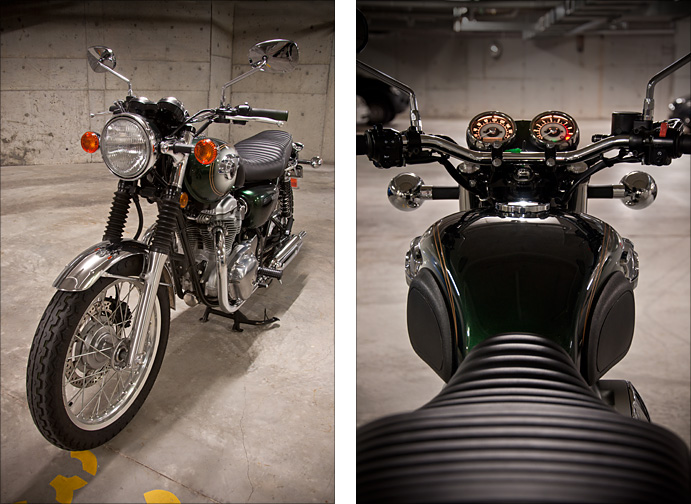 It has a habit of looking tall and lean from some angles, and quite wide from others
It has a habit of looking tall and lean from some angles, and quite wide from others
Torque is there in spades, and all from about 2 rpm. I’ve ridden a few bikes that are really unhappy to do anything but idle in the lower quarter of their rev range. Not the W; it and it’s nice big flywheel were totally untroubled by low rev riding. Like any decent, torquey engine you can just leave it in gear and punt it around using the bloody great mass of twist the engine generates. Likewise, cruising at high speeds seems just as easy, ticking over at a lazy 4250 rpm at 120 kmh (60 mph) and a crazy-low 2750 at 80 kmh (50 mph). Roll on the throttle and the thing just goes like the high god of tarmac has summoned a surf-able road wave behind you. It never gets hurried or flustered, and although the red line is painted on at a reasonably high 7000 rpm it always seemed to be very at-home-on-the-couch-without-any-pants-on comfortable despite whatever my right hand threw at it.
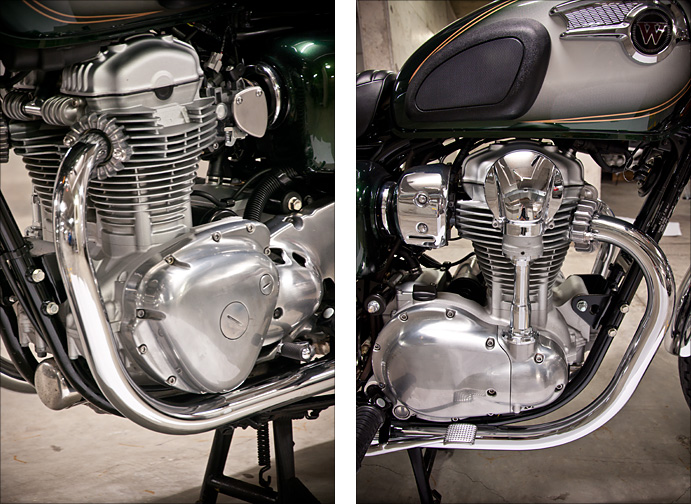 Yes, the engine looks amazing. Note bevel drive for cams
Yes, the engine looks amazing. Note bevel drive for cams
One thing that did arise from my inner city riding was the tendency for the ‘box to drop into neutral on its way up from first to second. Undoubtedly it was more than a little to do with getting used to the cog-swapping habits of the bike, but it continued more than a few days into my loan and went from generating a slight sigh to a fully-blown helmet-full of toilet language after a few neutral-induced redlines as my left boot found nothing but warm oil on the other end of the gear lever. More than a little embarrassing, too. Hopefully this would remove itself from the picture with a bit more practice and a few more miles on the clocks. Then again, the rather pleasant flipside to this was a very easy neutral selection when rolling to a stop in traffic.
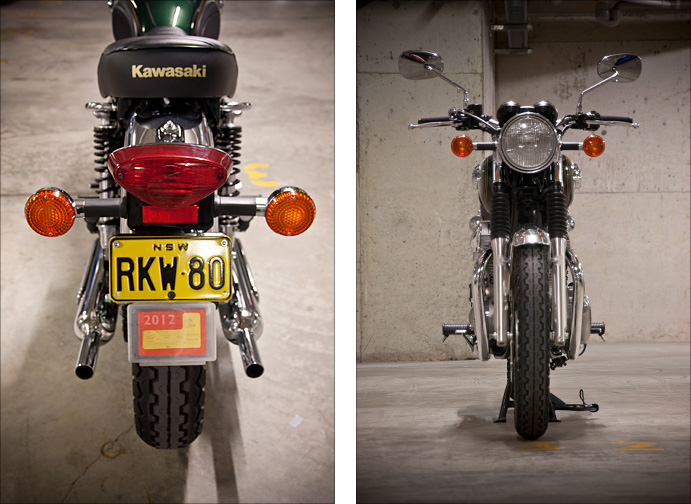 Large indicators enable you to be seen by other motorists and take shelter should it rain unexpectedly
Large indicators enable you to be seen by other motorists and take shelter should it rain unexpectedly
Of course, after I became a little familiar with its looks my mind turned to possible customization options for the bike. Ideally I’d like to ditch as much metal as possible with the intention of getting it out of the 200s and back into the low 190s or high 180s, kilo-wise. The tank would definitely have to go (or at least get the chop) and I’ll have to slap you if you didn’t guess that I’d want to free up the restrictions on those beautiful pipes to let the much-repressed natural songs of the parallel twin out into the open air. I’d also hit eBay for a standard “written” Kawasaki badge (or even an old W650 item) to replace the weird-ass big “W” living there now. Thanks for nothing Kawasaki Marketing Department. Scott tells me that Deus have just wheeled out a mild custom W800 which is now sitting in their Camperdown shop (see iPhone picture below), and a quick search on Google reveals that Kawasaki Japan offer a few sweet aftermarket accessories including a new cowl seat, colour, and bikini fairing. Word is they will be available outside Japan sooner rather than later.
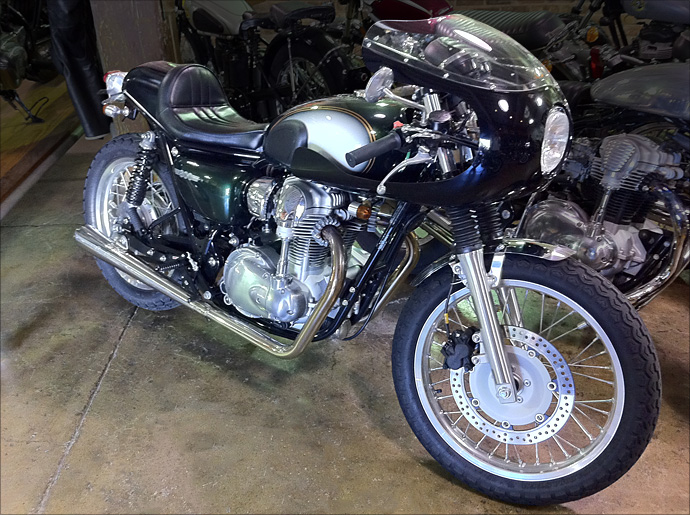 A crappy photo I took in Deus this afternoon of their mildly-modded W800. New pipes? Check. No weird tank badges? Check. Great minds…
A crappy photo I took in Deus this afternoon of their mildly-modded W800. New pipes? Check. No weird tank badges? Check. Great minds…
I’ve a had a week or two to mull things over with the W800 after it’s return and it struck me that in a lot of ways the bike is to classic motorcycles like a cover version is to the original song. Now don’t take that the wrong way; I’m not taking a shot at the bike but rather trying to express the way the bike looks like the real deal but upon closer inspection it is actually a lot more slick, precise, and modern that it may first appear. Getting this mix is quite the art form, and I think that Kawasaki have done a pretty good job at picking and choosing just what should rock and swagger like Jimi Hendrix and what should glide and bleep like LCD Soundsystem. With the notable exception of that overly fascistic exhaust, the bike has the mix bang-on as far as I’m concerned.
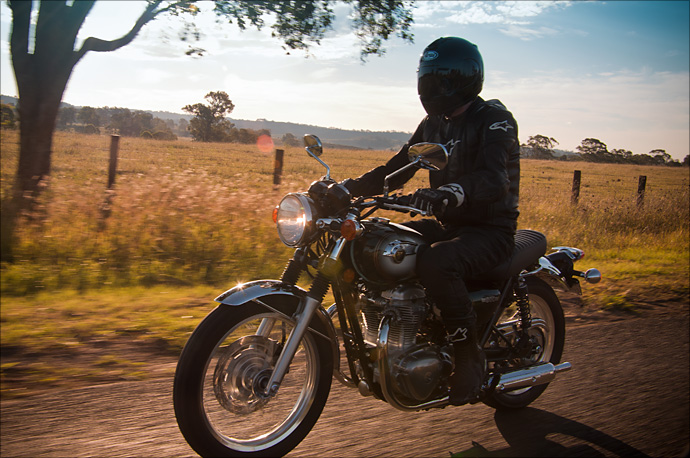 But does it actually do the retro thing? Hell yes!
But does it actually do the retro thing? Hell yes!
The W’s true test will be how it fares in the market place against the likes of Triumph’s Bonneville and T100 variant. In Australia the W has the price advantage over the Bonnie along with less chub and roughly the same oomph. Obviously it has tradition against it and as much as Kawasaki would like us to believe the W has a family photo album full of old, yellowing shots of the W1, I think the Triumphs do have it, erm, trumped on this front. We’ve not reviewed any of the Bonneville-based bikes as of yet but I’d sure be interested in doing a back-to-back with the two to see exactly how things stack up. As a solo act, the W800 was a hit with us and I’d happily pop in my own lot as the ride of choice when you’re feeling a little nostalgic but could do without the oil leaks and breakdowns. Nice one team green. Pipeburn recommended.
